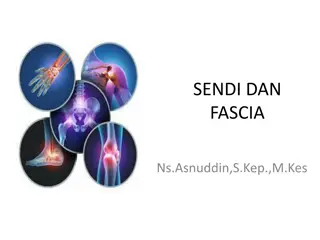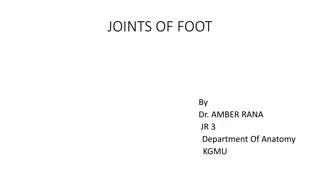Understanding Tibiofibular Joints in Leg Anatomy
Tibiofibular joints are crucial for leg stability and weight-bearing. The proximal and distal joints between the tibia and fibula allow minimal movement but provide essential support. The articulating surfaces, supporting structures, and neurovascular supply of both joints play key roles in leg function and health. Explore the detailed anatomy and function of tibiofibular joints.
Download Presentation

Please find below an Image/Link to download the presentation.
The content on the website is provided AS IS for your information and personal use only. It may not be sold, licensed, or shared on other websites without obtaining consent from the author. Download presentation by click this link. If you encounter any issues during the download, it is possible that the publisher has removed the file from their server.
E N D
Presentation Transcript
Tibiofibular Joints BY MBBSPPT.COM
Tibiofibular Joints The proximal and distal tibiofibular joints refer to two articulations between the tibia and fibula of the leg. These joints have minimal function in terms of movement but play a greater role in stability and weight-bearing. MBBSPPT.COM 2
Tibiofibular Joints Anterior view of the right proximal and distal tibiofibular joints. MBBSPPT.COM 3
Proximal Tibiofibular Joint Articulating Surfaces: The proximal tibiofibular joint is formed by an articulation between the head of the fibula and the lateral condyle of the tibia. It is a plane type synovial joint; where the bones to glide over one another to create movement. MBBSPPT.COM 4
Proximal Tibiofibular Joint Supporting Structures: The articular surfaces of the proximal tibiofibular joint are lined with hyaline cartilage and contained within a joint capsule. MBBSPPT.COM 5
Proximal Tibiofibular Joint The joint capsule receives additional support from: Anterior and posterior superior tibiofibular ligaments span between the fibular head and lateral tibial condyle Lateral collateral ligament of the knee joint Biceps femoris provides reinforcement as it inserts onto the fibular head. MBBSPPT.COM 6
Proximal Tibiofibular Joint Neurovascular Supply: The arterial supply to the proximal tibiofibular joint is via the inferior genicular arteries and the anterior tibial recurrent arteries. The joint is innervated by branches of the common fibular nerve and the nerve to the popliteus (a branch of the tibial nerve). MBBSPPT.COM 7
Proximal Tibiofibular Joint MBBSPPT.COM 8
Distal Tibiofibular Joint Articulating Surfaces: The distal (inferior) tibiofibular joint consists of an articulation between the fibular notch of the distal tibia and the fibula. It is an example of a fibrous joint, where the joint surfaces are by bound by tough, fibrous tissue. MBBSPPT.COM 9
Distal Tibiofibular Joint Supporting Structures: The distal tibiofibular joint is supported by: Interosseous membrane a fibrous structure spanning the length of the tibia and fibula. Anterior and posterior inferior tibiofibular ligaments Inferior transverse tibiofibular ligament a continuation of the posterior inferior tibiofibular ligament. As it is a fibrous joint, the distal tibiofibular joint does not have a joint capsule (only synovial joints have a joint capsule). MBBSPPT.COM 10
Distal Tibiofibular Joint A syndesmosis is a fibrous joint between two bones and linked by ligaments and a strong membrane. The distal tibiofibular syndesmosis is a syndesmotic joint. It is formed between the distal tibia and fibula and it is attached by The interosseous ligament (IOL), The anterior-inferior tibiofibular ligament (AITFL), The posterior-inferior tibiofibular ligament The (PITFL)the transverse tibiofibular ligament (TTFL). MBBSPPT.COM 11
Distal Tibiofibular Joint The left distal tibiofibular joint, supported by the interosseous membrane and the anterior inferior tibiofibular ligament. The posterior ligaments are not visible in this illustration. https://teachmeanatomy.info/wp-content/uploads/Distal-Tibiofibular-Joint.jpg MBBSPPT.COM 12
Distal Tibiofibular Joint Neurovascular Supply: Arterial supply to the distal tibiofibular joint is via branches of the fibular artery and the anterior and posterior tibial arteries. The nerve supply is derived from the deep peroneal and tibial nerves. MBBSPPT.COM 13
Clinical Relevance Dislocation of the Proximal Tibiofibular Joint A proximal tibiofibular joint dislocation is a rare and often missed diagnosis. It accounts for <1% of all knee injuries. The typical mechanism of injury is a fall onto an adducted and flexed knee. They can also occur as a result of high-energy trauma. Common clinical features include inability to weight-bear, lateral knee pain and tenderness/prominence of the fibular head. This type of injury is typically treated with a closed reduction (a reduction is a procedure to restore the joint to its natural alignment). Complications of proximal tibiofibular joint dislocation include common fibular nerve injury (the nerve winds around the neck of the fibula), and recurrent dislocation. MBBSPPT.COM 14
Interosseus Membrane of Leg (Middle Tibiofibular Ligament) This ligament extends through the fibula and tibia's interosseous borders and separates the muscles in the back of the leg from the muscles located in the front of the leg. It is made of an aponeurotic lamina, which is a thin layer of oblique, tendon-like fibers. Most of the fibers run laterally and downwards while the others run in an opposite direction. MBBSPPT.COM 15
Interosseus Membrane of Leg (Middle Tibiofibular Ligament) The ligament thins out at the lower portion, but is broader in the upper half. The upper portion of the interosseous membrane of leg does not reach the tibiofibular joint, but does create a large concave border that allows the anterior tibial vessels to pass through to the front of the leg. The lower part of the interosseous membrane of leg there is an opening so that the anterior peroneal vessels can pass through. In addition to the two main openings for the passage of vessels, there are also numerous openings so that small vessels can pass through. MBBSPPT.COM 16
Interosseus Membrane of Leg (Middle Tibiofibular Ligament) Function: The inferior segment assists in stabilising the tibiofibular syndesmosis. MBBSPPT.COM 17
DESCRIPTION PROXIMAL ATTACHMENT DISTAL ATTACHMENT ROLE / FUNCTION LIGAMENTS One of the primary stabilisers Limits excessive: external rotation of the foot on the leg Anterior-inferior tibiofibular ligament (AITFL) Trapezoid shape (the tibial insertion is wider) The ligament runs obliquely Weaker than the PITFL 20% intra-articular Anterior tubercle of the distal tibia Anterior surface of the distal fibula at the lateral malleolus distal fibular motion on the tibia One of the primary stabilisers Limits excessive: external rotation of the foot on the leg Posterior or posterior- inferior tibiofibular ligament (PITFL) Strong compact ligament Known as the Superficial component of the PITFL Posterior edge of the lateral malleolus Posterior tibial tubercle distal fibular motion on the tibia Forms a true labrum Provides talocrural joint stability. Prevents Posterior translation Transverse ligament or the Transverse tibiofibular ligament (TTFL) Cone shaped Also known as the Deep component of the PTIFL Proximal area of the malleolar fossa Posterior edge of the tibia -- directly posterior to the cartilaginous covering of the inferior tibial articular surface and may extent up to the medial malleolus One of the primary stabilisers Buffer to neutralise forces during weight bearing as it transfers some of the axial compressive load to the fibula 'Spring' action - allowing for minor separation between the distal tibia and fibula during dorsiflexion. Allowing slight wedging of the talus in the mortise Interosseus ligament or the interosseous tibiofibular ligament (IOL) Thickened portion of the distal interosseous membrane Dense mass of short fibers with adipose tissue and small branching vessels from the peroneal artery Span between the tibia and fibula The most proximal fibres attach to the apex of the incisura tibialis on the tibia Most distal fibres attach to the anterior tubercle of the tibia and descends straight to the talocrural joint of the fibula The length of the fibres increase from proximal to distal MBBSPPT.COM 18
Lateral view of ankle.PNG MBBSPPT.COM 19
Interosseous membrane.JPG MBBSPPT.COM 20
Thank You!























